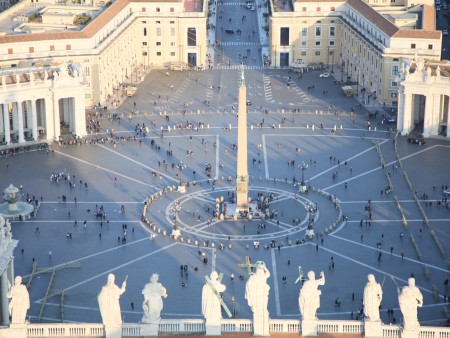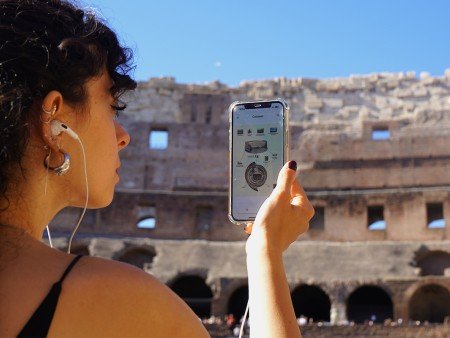13 Hidden Gems of the Trevi Fountain: Uncover its artistic details and the surrounding
This guide reveals the top 13 must-see details that will deepen your appreciation for the world's most famous fountain
20 August 2024
Things to do in RomeThe Trevi Fountain is one of the most recognizable symbols of Rome and one of the most famous fountains in the world. Besides being an essential stop for those visiting the Italian capital, the fountain is a true masterpiece of Baroque art, rich in fascinating details and symbolic meanings. Here are the 13 best things to see at the Trevi Fountain to fully appreciate its beauty and history.
1. The Statue of Oceanus
At the center of the Trevi Fountain stands the majestic statue of Oceanus, the god of the sea. This imposing figure drives a shell-shaped chariot pulled by sea horses. Oceanus represents the dominion of the waters and the power of nature, becoming the visual focal point of the fountain.
2. The Sea Horses
On either side of Oceanus' chariot, you'll find two winged sea horses, each with a distinct personality. One is restless and wild, symbolizing the untamable nature of the sea, while the other is calm and gentle, representing the tranquility of the waters. These horses add dynamism to the composition and reflect the balance between strength and serenity.
3. The Statues of Abundance and Health
On either side of Oceanus, there are two female figures embodying Abundance and Health. Abundance holds a cornucopia, a symbol of prosperity and wealth, while Health pours water from an amphora, representing purity and well-being. These statues enrich the symbolic meaning of the fountain, connecting it to themes of prosperity and health.
4. The Bas-Reliefs of the Aqua Virgo Aqueduct
Above the statues of Abundance and Health are two bas-reliefs that narrate the legend of the Aqua Virgo aqueduct, the system that feeds the Trevi Fountain. One relief depicts the virgin showing the Roman soldiers the source of the water, while the other represents the construction of the aqueduct itself. These historical reliefs are a testament to the importance of water for Rome.
5. The Monumental Basin
At the foot of the fountain is a large basin, designed to amplify the visual effect of the monument. The water gently flows into the basin, creating a reflection that enhances the sculptures above. The basin not only adds an additional element of beauty but is also the place where visitors throw their coins to express their wish to return to Rome.
6. The Façade of Palazzo Poli
The Trevi Fountain is set against the façade of Palazzo Poli, an imposing historical building that serves as a backdrop for the fountain. This palace, with its elegant windows and majestic architecture, completes the beauty of the monumental complex, offering an architectural context that enhances the grandeur of the fountain.
7. The Aqua Virgo Aqueduct
A less visible but crucial detail is the Aqua Virgo aqueduct, which supplies the Trevi Fountain with fresh, pure water. Built in 19 B.C., this ancient aqueduct is one of the few still functioning in Rome and represents a direct link to the advanced engineering of ancient Rome.
8. Floral Decorations
In addition to the main statues, the Trevi Fountain is adorned with floral details carved in marble. These decorative motifs represent the lush nature that accompanies the aquatic theme of the fountain, adding further depth and visual richness to the monument.
9. The Coin Tradition
One of the most beloved traditions for visitors to the Trevi Fountain is throwing a coin into the basin, hoping to return to Rome. It is said that tossing one coin ensures a return to the Eternal City, two coins bring a new romance, and three coins guarantee a marriage. This custom makes the visit even more memorable.
10. Night Lighting
The Trevi Fountain is spectacular during the day, but at night it becomes truly magical. The night lighting highlights the sculptures and reliefs, creating a suggestive atmosphere that enhances the beauty of the fountain. A night visit is a must for anyone who wants to see the fountain in a different light. Enjoy a captivating view of the Trevi Fountain with us on the Dreamy Rome City Tour: Trevi Fountain undergrounds, awesome squares and amazing tiramisu where you can experience the magic of Rome at sunset time.
11. The Surroundings of the Fountain
The Trevi Fountain is located in a lively and charming neighborhood, full of narrow streets, historic cafés, and artisan boutiques. Walking around the fountain, you can discover hidden corners of Rome and enjoy the city's authentic atmosphere.
12. The Church of Saints Vincent and Anastasius
In the immediate vicinity of the Trevi Fountain is the Baroque church of Saints Vincent and Anastasius. This church, with its richly decorated façade, is a small architectural treasure that deserves a visit to admire its artistic and historical details.
13. The Movie Scenes
The Trevi Fountain has played a starring role in numerous films, the most famous of which is Federico Fellini's "La Dolce Vita." The scene where Anita Ekberg wades into the fountain's waters has become iconic and helped make this location famous worldwide. Reliving these cinematic moments while admiring the fountain adds an extra layer of charm to the visit.
These 13 things to see at the Trevi Fountain offer a complete and meaningful experience that goes far beyond simply admiring its beauty. Every detail, every sculpture, and every legend contribute to creating a deep connection between the visitor and the history of Rome.
Our categories:
You may also be interested ...

Vatican Private Tour with Sistine Chapel & St. Peter's Basilica: Renaissance’s Wonders
Private tour
Discover with a skip the line Private Vatican Tour the Sistine Chapel, Vatican Museums and St Peter’s Basilica
starting from: € 275

Colosseum Guided Audio Tour with Roman Forum and Palatine Hill
Private tour
Discover Ancient Rome’s secrets and history with our immersive Colosseum guided audio tour, rich in image and content
starting from: € 51 € 42